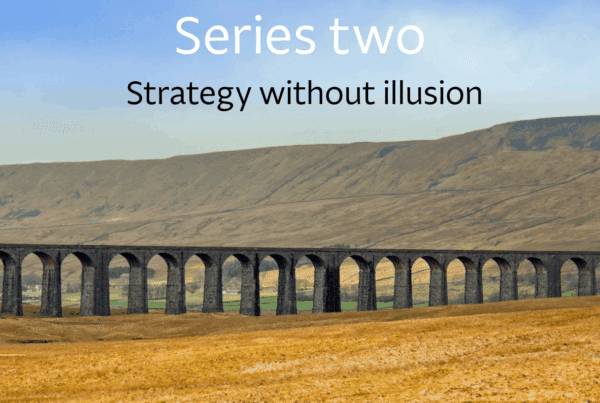You Don’t Need a New Strategy: You Need Follow-Through
Part 2: Strategy Without Illusion
The moment targets are missed, someone suggests a new strategy.
It’s a familiar pattern. Q1 slips. Q2 disappoints. Performance wobbles, and suddenly the conversation turns to reinvention. New models. New messaging. A new direction of travel.
But in most cases, what’s needed isn’t a new strategic framework. It’s systematic execution of the existing strategic intent through The Strategic Multiplication Framework™. It’s clarity about what the current strategy actually means operationally. It’s focus on translating strategic knowledge into consistent operational results.
What’s missing is strategic follow-through that multiplies capability rather than replacing direction.
When reinvention becomes a reflex
Changing strategy can feel like decisive leadership. It creates activity around strategic thinking. It signals renewed ambition. And it gives everyone something fresh to believe in again.
But often, it’s just sophisticated procrastination. A way of avoiding the hard conversations about what operational capabilities haven’t been developed, or where strategic accountability has quietly drifted. Shiny new strategic direction. Same lack of systematic follow-through on strategic intent.
There’s a crucial difference between a fundamentally flawed strategy and a strategically sound plan that was never properly implemented. Most businesses don’t fail because their strategic thinking was wrong. They fail because they couldn’t systematically translate that strategic thinking into operational execution that builds and compounds over time. And rather than facing that multiplication challenge, they pivot to new strategic directions.
This isn’t to say strategic direction can’t or shouldn’t be refreshed when market conditions genuinely change. In many cases, the existing strategy was never truly launched with clear operational intent. The team never saw it as actionable guidance for daily decision-making. They never developed the capability to execute strategic intent systematically.
That’s why part of strategic multiplication work involves turning existing strategic thinking into what I call “see-through vision”: operational guidance that every person in the business can understand, connect with, and apply to their specific responsibilities. If people can’t see how their work contributes to strategic outcomes, they won’t coordinate effectively around strategic intent.
Why strategic pivoting keeps happening
The psychology is straightforward. Abandoning the current strategic direction feels easier than confronting where systematic execution has gone off course. It feels like strategic progress, even when it’s really just avoiding the hard work of building execution capability.
The cultural reinforcement makes it worse. Teams are praised for fresh strategic thinking, not disciplined delivery against existing strategic intent. Boards reward visionary strategic presentations, not operational rhythm that translates strategy into results. Strategic discussion becomes performance theatre, not systematic capability building.
The leadership avoidance factor compounds the problem. When strategic objectives drift and operational results disappoint, a strategic reset feels safer than conducting an honest assessment of why strategic intent didn’t translate into operational effectiveness. It’s more comfortable to assume the strategy was wrong than to examine why strategic multiplication never happened.
The multiplication alternative to strategic pivoting
Before concluding that strategic direction needs to change, The Strategic Multiplication Framework™ suggests asking different questions: Did the strategy genuinely fail to account for market reality? Or did we simply not develop the systematic capability to execute strategic intent effectively? Have we created the organisational conditions for consistent translation of strategic knowledge into operational results? Is this strategic pivot really about market-driven necessity, or is it about avoiding the harder work of building execution capability?
This isn’t about avoiding necessary strategic adjustments when competitive conditions genuinely shift. It’s about distinguishing between strategic failures and execution failures, then addressing the actual problem systematically.
The role of multiplication leadership
From the touchline, it’s easy to be seduced by the appeal of fresh strategic thinking. But real multiplication value often lies in protecting strategic continuity while building the capability to execute it systematically.
The most effective Chairs, NEDs, Portfolio Managers, CEOs, and Managing Directors know when to ask whether the current strategic direction really failed, or whether systematic follow-through was never properly established. Have we built the organisational capability for consistent strategic execution? Is this desire for strategic change really about market-driven strategy, or is it about leadership comfort with starting fresh rather than building execution discipline?
This isn’t about stifling necessary strategic evolution. It’s about distinguishing between strategic problems and execution problems, then applying The Strategic Multiplication Framework™ to solve the actual challenge rather than assuming strategic direction is the issue.
Multiplication leadership means creating space for teams to build systematic execution capability around existing strategic intent, and only changing strategic direction when external conditions genuinely require it, not when internal execution capability hasn’t been developed.
Strategic follow-through as organisational capability
Strategic follow-through isn’t about micromanagement or increased oversight. It’s about building organisational rhythm, execution discipline, and operational visibility that systematically translates strategic intent into coordinated action that builds toward strategic outcomes.
Strategy needs operational rituals that build execution capability over time. Regular strategic check-ins that assess progress against strategic intent, not just tactical activities. Clear ownership of strategic outcomes, not just task completion. Focused updates that connect operational decisions to strategic direction. Systematic accountability for strategic progress that builds capability rather than creates compliance pressure.
Not more meetings about strategy, just more effective operational rhythm that keeps strategic intent alive in daily decision-making.
One of the advantages of the one-page strategic intent framework I develop with teams is that it becomes a living, breathing part of how the business operates strategically. It’s embedded in weekly and monthly operational rhythms, not stored away after strategic planning sessions. When implemented properly through The Strategic Multiplication Framework™, it acts as distributed strategic guidance that helps teams make consistent decisions that build toward strategic outcomes.
This framework helps answer: What strategic outcomes are we building toward? What operational decisions support those outcomes? Where might we be losing strategic focus in daily execution? How do we reconnect operational activities with strategic intent when they inevitably drift?
Building multiplication culture, not just strategic culture
As an interim CEO, much of my work involves implementing The Strategic Multiplication Framework™ to help capable teams coordinate more effectively around strategic intent. Most businesses I work with have good people and sound strategic thinking. The issue isn’t capability or strategic direction. It’s that individual capabilities haven’t been systematically coordinated into collective strategic effectiveness.
Too often, people throughout the organisation aren’t clear about how their operational decisions should support strategic outcomes. They know their functional responsibilities, but they don’t understand how those responsibilities connect to broader strategic intent. That’s why my leadership approach has always been: strategic intent focused, capability multiplication oriented.
The multiplication culture that effective leaders build addresses this systematic coordination challenge. It’s not about strategic vision that inspires, though that matters. It’s about operational clarity that enables systematic strategic execution through enhanced collective capability.
This culture includes several key elements that distinguish it from traditional strategic culture or execution culture alone.
Strategic intent clarity that guides operational decisions. Everyone understands not just what the strategy is, but how their specific decisions and activities should support strategic outcomes. The strategic framework provides decision-making guidance, not just aspirational direction.
Execution capability that builds and compounds over time. Teams don’t just execute tactical tasks, they develop systematic approaches to translating strategic intent into operational results that build competitive advantage through enhanced organisational capability.
Adaptive decision-making within clear strategic boundaries. People can respond to changing operational conditions while maintaining strategic alignment because they understand strategic intent clearly enough to adapt tactics without losing strategic direction.
Performance acceleration through collective strategic thinking. Results improve not just through better individual performance, but through better collective capability to coordinate activities around strategic outcomes that compound over time.
The systematic approach to strategic follow-through
The Strategic Multiplication Framework™ provides systematic approaches to building strategic follow-through capability rather than just monitoring strategic compliance.
Strategic intent reinforcement through operational rhythm. Regular check-ins that assess whether operational decisions are building toward strategic outcomes, and where strategic focus might be drifting in daily execution pressures.
Capability multiplication through systematic skill building. Developing the organisational ability to translate strategic thinking into operational coordination that improves over time, rather than just executing current tactics more efficiently.
Adaptive execution within strategic parameters. Building teams’ capability to adjust operational approaches while maintaining strategic alignment, rather than requiring constant strategic direction for every operational decision.
Compound strategic progress through systematic measurement. Tracking not just whether tactical targets are met, but whether operational capabilities are building in ways that support long-term strategic positioning and competitive advantage.
When strategic direction genuinely needs adjustment
This focus on strategic follow-through doesn’t mean strategic direction should never change. Markets shift, competitive conditions evolve, and customer needs develop in ways that genuinely require strategic adjustment.
The key is distinguishing between necessary strategic evolution driven by external factors and strategic changing driven by internal execution challenges that could be solved through better systematic follow-through.
External factors that might genuinely require strategic adjustment include significant shifts in competitive dynamics that change the strategic context, fundamental changes in customer behavior that alter strategic assumptions, regulatory or technology changes that reshape strategic possibilities, or market conditions that make current strategic direction economically unviable.
Internal factors that suggest execution challenges rather than strategic problems include inconsistent operational results despite clear strategic direction, teams that understand strategic intent but struggle to coordinate effectively, good individual performance that doesn’t translate into collective strategic progress, or strategic outcomes that seem achievable but aren’t being systematically pursued.
The Strategic Multiplication Framework™ helps distinguish between these scenarios by assessing whether the organisational capability exists to execute the current strategic direction systematically. If that capability hasn’t been built, changing strategic direction rarely solves the underlying execution challenge.
The compound value of strategic persistence
When strategic direction is fundamentally sound and market-appropriate, systematic follow-through through The Strategic Multiplication Framework™ creates compound value that strategic pivoting rarely achieves.
Teams that build systematic execution capability around consistent strategic intent develop organisational advantages that are difficult for competitors to copy. They build market positioning through sustained strategic focus rather than scattered tactical activities. They develop internal capabilities that accelerate future strategic execution. They create customer relationships and market reputation based on reliable strategic delivery.
Most importantly, they build the organisational confidence that comes from systematic strategic achievement, which enables more ambitious strategic objectives over time.
This compound value is lost every time strategic direction changes before systematic execution capability has been fully developed and tested against market reality.
The multiplication leader’s strategic discipline
For leaders operating from the touchline, the discipline isn’t just about when to change strategic direction. It’s about when to protect strategic continuity while building the systematic capability to execute that direction effectively.
This requires the patience to build execution capability systematically rather than the excitement of developing new strategic direction. The confidence to address execution challenges directly rather than the comfort of assuming strategic challenges. The discipline to ask hard questions about execution effectiveness rather than the distraction of strategic alternatives.
Most importantly, it requires the systematic approach that The Strategic Multiplication Framework™ provides for translating strategic knowledge into operational results that compound over time.
That’s often the missing link between sound strategic thinking and sustainable competitive advantage.
The Strategic Multiplication Framework™ forms part of my strategic operations consulting approach. Working as Chair/NED, Interim CEO, or Executive Coach, I help senior management teams multiply their strategic knowledge and operational effectiveness.
Follow the complete “Strategy Without Illusion” series for systematic approaches to building strategic execution capability that compounds over time.


